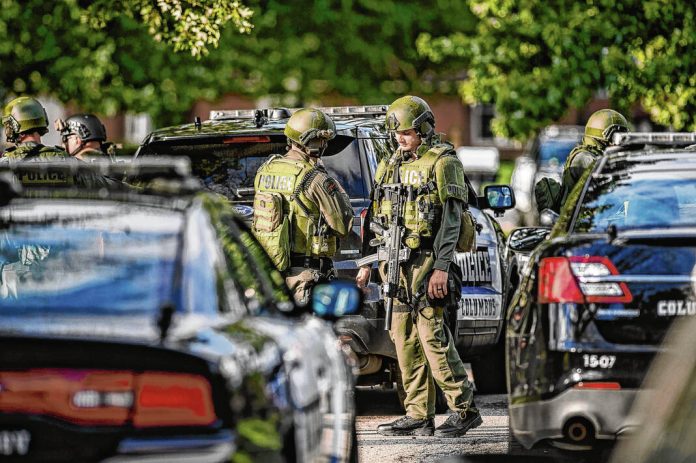
Members of the SWAT team stand between parked police cars during a stand off on Aspen Lane in Columbus, Ind., Tuesday, Sept. 25, 2018. Mike Wolanin | The Republic
Local police and first responders are warning against “swatting” following an apparent hoax call involving a fake report of a homicide and hostage situation that drew multiple police units to a Columbus home last week.
Swatting refers to a malicious prank or form of harassment in which someone makes a false report of a serious crime with the goal of prompting a significant law enforcement response at a specific address.
In 2023, there were two incidents of swatting in Columbus, said Columbus Police Department spokesman Lt. Matt Harris, who could not recall any cases in 2022.
“We’re seeing it here, just like other communities,” Harris said. “We’re not immune from that.”
The incident last week began with a call to the Bartholomew County Emergency Operations Center at around 7:45 p.m. on Dec. 27 in which an unknown caller falsely claimed that he had killed a woman and was holding a man hostage at a residence on Chandler Lane, officials said. The caller also claimed to be armed with an assault rifle.
CPD responded by sending multiple units to the home and forcing entry into the residence. However, nobody was there.
The home belongs to Paul and Kimberly Hoffman, who were out of town at the time. Paul Hoffman, an author, publisher and former Republic special publications editor, was a candidate for Columbus City Council at-large in the 2023 municipal election and previously ran for Bartholomew County Council.
“It’s like, ‘Oh my gosh, I can’t believe somebody did that. Who would do that? Why would they do it? Was I targeted? Was my wife targeted? Was it some random thing?’” Paul Hoffman said. “…The most disconcerting thing for me right now is I don’t know why, and I don’t know who. So is it going to happen again? Is it going to happen while we’re home? Will it be late at night?”
“You don’t know if anything like this can escalate, especially when you don’t know why,” he added.
Currently, the Hoffmans have no working front door after the forced entry by police. They have bolted the door in place but cannot open it, so they have to enter and exit their home through the garage or back door.
When police forced entry into their home, they removed the door by its hinges, Paul Hoffman said. The door then scraped against a wall, causing a gouge that will need to be fixed, before falling on top of a humidifier, destroying it.
“If (the police) think there is something terribly dangerous on the other said of the door, I don’t know what else they are supposed to do,” Paul Hoffman said. “…It’s just unfortunate. It wastes their time. It wastes everyone’s money. And it is also an emotional thing.”
Harris said Columbus police “don’t normally do that (force entry into a home)” but “we had an obligation to make sure that no one was injured inside the home.”
That incident came nearly six months after Columbus police received a report of someone being shot at another local residence. When officers arrived on the scene, they briefly detained a juvenile, who they now believe was the victim of swatting following an argument related to an online video game.
“We believe that it possibly involved an argument over or during an online video game,” Harris said. “We’ve seen this in other communities where younger persons are playing video games online, and a disagreement or something occurs, and then swatting taking place after that.”
In at least one of the incidents last year a spoof phone number was used to contact emergency dispatchers, Harris said. The call that resulted in the incident last week came in through the Bartholomew County Emergency Operations Center’s non-emergency phone line, officials said.
While the emergency operations center sometimes does receive reports of emergencies through its non-emergency phone line, “most of the emergency calls that we receive are typically on 911,” said Bartholomew County Operations Director Todd Noblitt.
“It is concerning from the standpoint that (swatting) is happening everywhere,” Noblitt said. “…With today’s technology, it’s so tough to track where it’s coming from, and many times it’s not even from the same city or town or state.”
As of Friday, both cases remained under investigation, officials said. Police have not announced any arrests related to either incident.
National trend
The problem of swatting is becoming more widespread across the country, The Associated Press reported.
The Anti-Defamation League estimates that by 2019 there were over 1,000 swatting incidents each year in the United States. The group says swatting originated in online communities associated with gamers and hackers, and each incident can cost taxpayers thousands of dollars in emergency response costs.
Late last year, there were a series of swatting incidents targeting public officials, including U.S. Sen. Rick Scott of Florida, Boston Mayor Michelle Wu, Georgia U.S. Rep. Marjorie Taylor Greene and Ohio Attorney General Dave Yost, according to wire reports.
There have also been reports of hundreds of swatting incidents and bomb threats against synagogues and other Jewish institutions since the Israel-Hamas war began.
Officials across the country have expressed concern about the incidents, which they say divert resources away from real emergencies and can pose risks for victims and police — and have proven deadly in some cases.
In 2017, a police officer in Wichita, Kansas, shot and killed a man while responding to a hoax emergency call stemming from a dispute between two online players over a $1.50 bet in the Call of Duty: WWII video game, The Associated Press reported.
The man who was killed was not involved in the dispute or the video game, according to wire reports. The individual who placed a call to Wichita police to falsely report a shooting and kidnapping had an incorrect address for their intended victim.
In 2015, police in Maryland shot a 20-year-old man in the face with rubber bullets after a fake hostage situation was reported at his home, according to wire reports.
More recently, a Tennessee man died of a heart attack as a result of a swatting case.
“When an officer gets a report of someone shot, their mindset is a little bit different that, just say, a car accident that they respond to,” Harris said, of the local incidents. “…They’re handled in totally different types of manners.”
While nobody was home during the incident in Columbus last week, the victim of the local swatting incident in June was home when police responded, which Harris said “can make for a dangerous situation” — particularly if the person, who may have no idea what is going on, is not cooperative.
In that case, the juvenile cooperated with police, and nobody was injured, Harris said.
“When there are serious statements being made of someone shot or someone murdered in a home, it can be dangerous for the person inside the home, especially dependent on the circumstances,” Harris said.
“It’s a very high-stress situation, and we are very fortunate that both of these incidents have ended with nobody being hurt,” Harris said.
Hard to screen calls
Local dispatchers, for their part, are trained to develop “investigative skills” that they use on every call they receive to help relay information to responding units, but they never know for sure if it is a swatting call until after the fact, Noblitt said.
“There are some common threats, and so when an emergency dispatcher takes that call, there are some things they’re looking for, listening for, questions they’re asking,” Noblitt said. “… If they are able to obtain certain information or they’re able to detect some behaviors or things that are said that will help law enforcement then they will relay that information.”
“When it’s a prank call — it could be a bomb threat or whatever — many times the caller is not going to stay on the phone and play 21 questions,” Noblitt added.
CPD will respond to all calls they receive, investigate and secure the scene, Harris said. But if the call turns out to be a hoax, it is “definitely a waste of law enforcement resources,” he said.
“People might think that it’s a joke or a prank, when in reality, the officers are responding (with) lights and sirens, which can be dangerous, driving quickly to a scene,” Harris said. “It takes away police resources. They could be handling other types of calls. And obviously, when we get a call like this, with a report of somebody is shot or there has been a homicide, it’s going to be a very large law enforcement response. …It’s definitely not a joke.”




